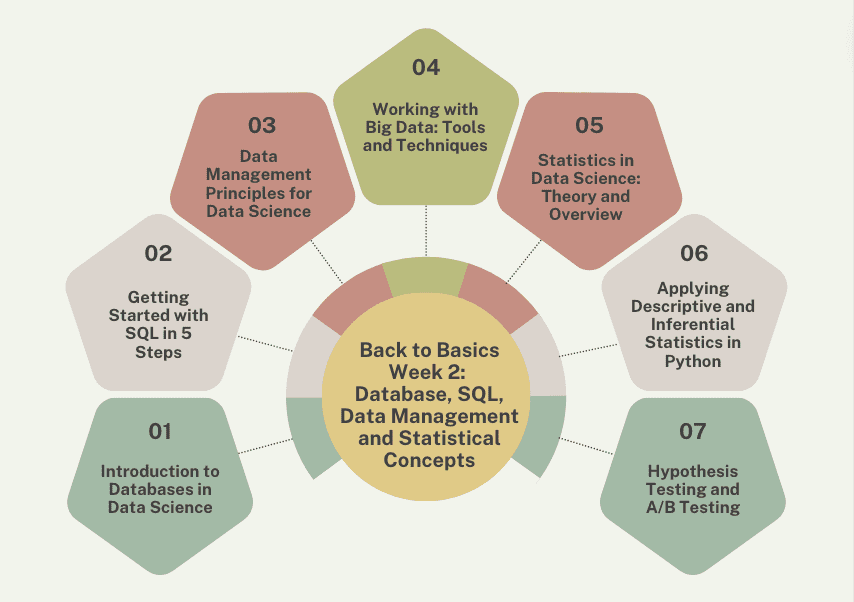
Image by author
Join KDnuggets with our back-to-basics journey to start a new career or brush up on your data science skills. The Back to Basics path is divided into 4 weeks with an extra week. We hope you can use these blogs as a guide to the course.
If you haven’t already, check out Week 1: Back to Basics Week 1: Python Programming and Data Science Fundamentals
Moving on to the second week, we will learn about databases, SQL, data management and statistical concepts.
- Day 1: Introduction to databases in data science
- Day 2: Introduction to SQL in 5 steps
- Day 3: Data Management Principles for Data Science
- Day 4: Working with Big Data: tools and techniques
- Day 5: Statistics in Data Science: Theory and Overview
- Day 6: Application of descriptive and inferential statistics in Python
- Day 7: Hypothesis testing and A/B testing
Week 2 – Part 1: Introduction to Databases in Data Science
Understand the relevance of databases in data science. Also learn relational database fundamentals, NoSQL database categories, and more.
Data science involves extracting value and insights from large volumes of data to drive business decisions. It also involves building predictive models using historical data. Databases facilitate efficient storage, management, retrieval and analysis of such large volumes of data.
So as a data scientist, you need to understand the fundamentals of databases. Because they enable the storage and management of large and complex data sets, enabling efficient data exploration, modeling, and insights.
Week 2 – Part 2: Introduction to SQL in 5 steps
When it comes to managing and manipulating data in relational databases, Structured Query Language (SQL) is the biggest name in the game. SQL is an important domain-specific language that serves as a cornerstone for database management and provides a standardized way to interact with databases.
With data being the driving force behind decision-making and innovation, SQL remains an essential technology that demands high-level attention from analysts, developers, and data scientists.
This comprehensive SQL tutorial covers everything from setting up your SQL environment to mastering advanced concepts like joins, subqueries, and optimizing query performance. With step-by-step examples, this guide is perfect for beginners looking to improve their data management skills.
Week 2 – Part 3: Data Management Principles for Data Science
Understand the key data management principles that data scientists should know.
Throughout your journey as a data scientist, you will encounter setbacks and overcome them. He will learn how one process is better than another and how to use different processes depending on the task at hand.
These processes will work hand in hand to ensure that your data science project is as effective as possible and plays a key component in your decision-making process.
Week 2 – Part 4: Working with Big Data: tools and techniques
Where to start in a field as vast as big data? What tools and techniques to use? We explore this and talk about the most common tools in big data.
Gone are the days in business when all the data you needed was in your “little black book.” In this era of the digital revolution, not even classic databases are enough.
Handling big data has become a fundamental skill for companies and, with them, for data scientists. Big data is characterized by its volume, velocity and variety, offering unprecedented insights into patterns and trends.
To handle such data effectively, the use of specialized tools and techniques is required.
Week 2 – Part 5: Statistics in Data Science: Theory and Overview
High-level exploration of the role of statistics in data science.
Are you interested in mastering statistics to excel in a data science interview? If so, you shouldn’t do it just for the interview. Understanding statistics can help you get deeper, more detailed insights from your data.
In this article, I am going to show the most important statistical concepts to know to improve data science problem solving.
Week 2 – Part 6: Applying descriptive and inferential statistics in Python
As you progress on your data science journey, these are the elementary statistics you should know.
Statistics is a field that encompasses activities ranging from data collection and analysis to data interpretation. It is a field of study to help the interested party decide in the face of uncertainty.
Two main branches in the field of statistics are descriptive and inferential. Descriptive statistics is a branch concerned with summarizing data using various forms such as summary statistics, visualization and tables. While inferential statistics has more to do with population generalization based on the data sample.
Week 2 – Part 7: Hypothesis Testing and A/B Testing
The pillars of data-based decisions.
In an era where data reigns supreme, companies and organizations are constantly looking for ways to harness its power.
From the products they recommend to you on Amazon to the content you see on social media, there is a meticulous method behind this madness.
At the center of these decisions? A/B testing and hypothesis testing.
But what are they and why are they so critical in our data-centric world? Let’s all find out together!
Congratulations on completing week 2!!
The KDnuggets team hopes that the Back to Basics path has provided readers with a comprehensive and structured approach to mastering the fundamentals of data science.
Week 3 will be released next week on Monday. Stay tuned!
nisha arya is a data scientist and freelance technical writer. She is particularly interested in providing professional data science advice or tutorials and theory-based data science insights. She also wants to explore the different ways in which artificial intelligence can benefit the longevity of human life. A great student looking to expand her technological knowledge and writing skills, while she helps guide others.
 NEWSLETTER
NEWSLETTER





